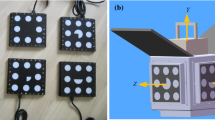Abstract
For finding an effective measurement for space non-cooperative targets in close distance, a vision-based position and pose determination algorithm of non-cooperative target for on-orbit servicing is investigated. First, the satellite-rocket docking ring’s region is separated from the background environment by a selected grayscale thresholding method and the Canny operator algorithm is used to extract the edge of the satellite-rocket docking ring. Furthermore, the mathematical alignment of the image plane and binocular stereo matching are used to obtain the correspondence of 3D points. Finally, the model of 3D reconstruction is established to determine the relative position and pose of the satellite-rocket docking ring. The ground simulation test shows that our method can measure the relative position and pose of the satellite-rocket docking ring effectively. The precision of the relative position is 0.001 m and that of the relative attitude is 0.1 deg., which satisfies the requirements of the relative measurement for non-cooperative target in extra-close range.












Similar content being viewed by others
References
Cai H, Zhang JR, Zhai G, Zhang Y (2005) Relative pose determination for GEO non-cooperative spacecraft under the ultra-close distance. J Astronaut 36:715–722
Canny J (1986) A computational approach to edge detection. IEEE Trans Pattern Anal Mach Intell 8(6):679–698
Chong S, Dong W, Huchuan L, Ming-Hsuan Y (2018) Correlation tracking via joint discrimination and reliability, IEEE Conference on Computer Vision and Pattern Recognition, accepted. http://openaccess.thecvf.com/content_cvpr_2018/papers/Sun_Correlation_Tracking_via_CVPR_2018_paper.pdf
David B, Brook S (2013) Phoenix project status 2013. AIAA Space 2013 Conf Expos: 1–28
Debus TJ, Dougherty SP (2009) Overview and performance of the front-end robotics enabling near-term demonstration (FREND) robotic arm. AIAA Infotech Aerospace Conference: 1–12
Dong W, Huchuan L, Ziyang X, Yang M (2015) Inverse sparse tracker with a locally weighted distance metric. IEEE Trans Image Process 24(9):2646–2657
Du X, Liang B, Xu W (2011) Pose measurement of large non-cooperative satellite based on collaborative cameras. Acta Astronautica 68(11):2047–2065
Huimin L, Yujie L, Shenglin M (2017) Motor anomaly detection for unmanned aerial vehicles using reinforcement learning. IEEE Internet Things J: 1–1
Huimin L, Yujie L, Min C (2017) Brain intelligence: go beyond artificial intelligence. Mobile Netw Appl 23(2):368–375
Huimin L, Bin L, Junwu Z (2017) Wound intensity correction and segmentation with convolutional neural networks. Concurr Comput: Pract Exper 29(6):1–10
Huimin L, Yujie L, Tomoki U (2018) Low illumination underwater light field images reconstruction using deep convolutional neural networks. Futur Gener Comput Syst 82:142–148
Ke Z, Miao S, Tony XH, Xingfang Y (2016) Residual networks of residual networks: multilevel residual networks. IEEE Trans Circ Syst Video Technol 28(6):1301–1314
Leinz MR, Chen CT (2008) Orbital express autonomous rendezvous and capture sensor system (ARCSS) flight test results. Proc SPIE 6958:69580A–695813A
Miravet C, Pascual L, Krouch E (2008) Image processing for autonomous rendezvous in the OLEV mission. Autom Congress: 1–6
Miravet C, Pascual L, Krouch E (2008) An image-based sensor system for autonomous rendezvous with uncooperative satellites. 7th Int ESA Conf Guid Navig Contrl Syst Tralee: 1–12
Seiichi S, Huimin L (2014) Underwater image dehazing using joint trilateral filter. Comput Electr Eng 40(1):41–50
Wingo DR (2004) Orbital recovery's responsive commercial space tug for life extension missions. The AIAA 2nd Respons Space Conf: 1–8
Xu WF, Liu Y, Liang B (2009) Measurement of relative poses between two non-cooperative spacecrafts. Optics Precision Eng 17(7):1571–1581
Acknowledgements
The authors acknowledge support from National Nature Science Foundation of China (No. 61690210, 61690215, 61571236).
Author information
Authors and Affiliations
Corresponding author
Additional information
Publisher’s Note
Springer Nature remains neutral with regard to jurisdictional claims in published maps and institutional affiliations.
Rights and permissions
About this article
Cite this article
Hu, H., Wang, D., Gao, H. et al. Vision-based position and pose determination of non-cooperative target for on-orbit servicing. Multimed Tools Appl 79, 14405–14418 (2020). https://doi.org/10.1007/s11042-018-6696-8
Received:
Revised:
Accepted:
Published:
Issue Date:
DOI: https://doi.org/10.1007/s11042-018-6696-8




